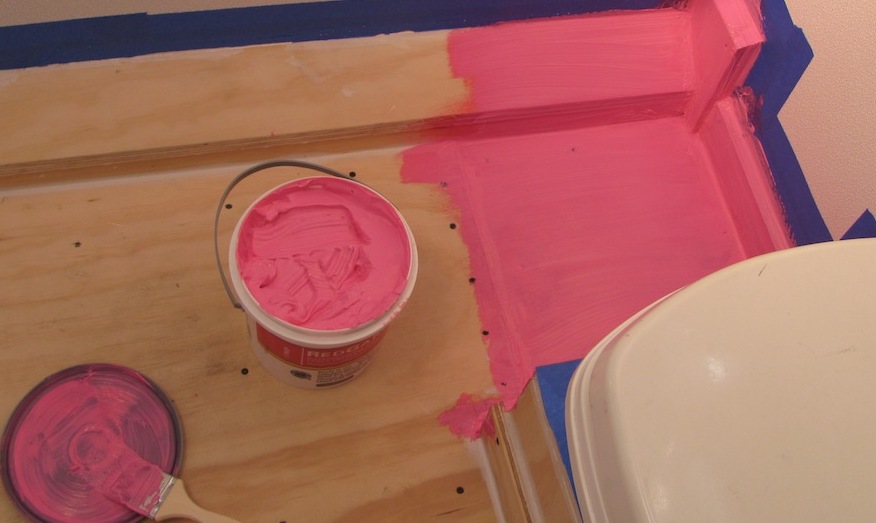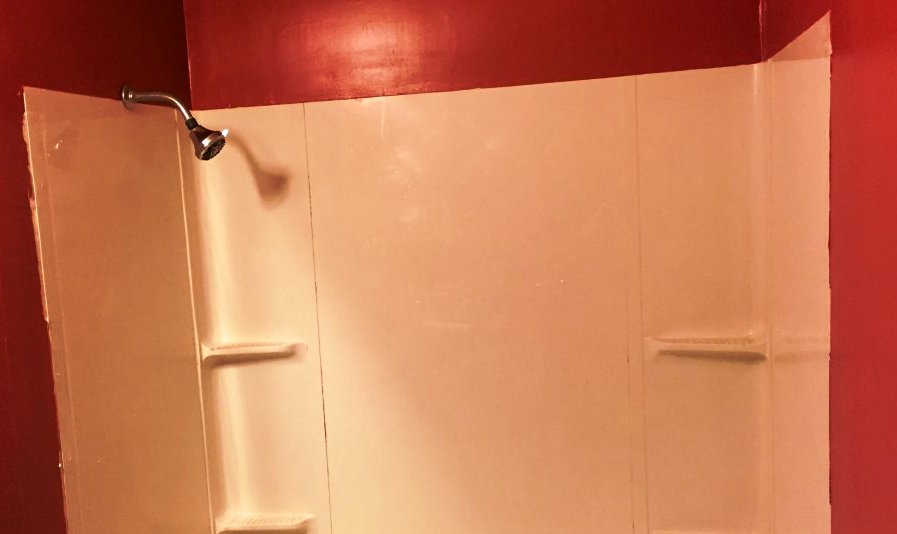Using RedGard Over KERDI

When installing a bathtub or shower, you have to be positive there won’t be any leaks. RedGard and Kerdi are a couple of the products you can use to waterproof your shower system.
It is best to use these two distinct systems independently of one another. To waterproof your shower, you can either use RedGard or Kerdi. The good news is that tile can be used to cover both. But because Kerdi is a pliable sheet, there will be seams when using it.
Kerdi offers a way to guarantee the waterproofness of the seams. But, you might be concerned about making sure the seams don’t let water through if you’re a contractor or do-it-yourself enthusiast.
Additionally, you might think about using RedGard over the seams. We’ll talk about RedGard’s applicability and whether it should be used over Kerdi seams today.
What Is A Kerdi And A RedGard?
We must define these two products in order to better understand their compatibility. These are flexible sheets that form a waterproofing layer, starting with kerdi.
Kerdi sheets are widely used in showers, bathtubs, steam rooms, and any other application that might need waterproofing because they provide a great barrier against moisture.
These sheets prevent mold development by keeping water at bay. Kerdi thinsets and sticks to tiles nicely. Every Kerdi sheet is the same thickness and 2 meters wide, so it can fit in most bathrooms.
RedGard, on the other hand, is a waterproofing membrane that is applied with liquid. Both residential and commercial buildings frequently use it.
RedGard works well on a variety of surfaces, including cement backer boards and concrete. RedGard not only forms a waterproofing membrane but also stops cracking.
By making sure water doesn’t seep into the substrates below, it achieves that. Due to RedGard’s ease of use, a lot of contractors and do-it-yourself builders adore it.
To apply it, all you need is a roller brush. It will also stop mold from growing behind your shower walls and is incredibly durable.
Can RedGard Be Placed Over Kerdi Seams?
As previously stated, Kerdi is made of flexible sheets that are affixed to the walls with thinset mortar. Seams must be used to connect these sheets.
Either lapped seams or butt-joined seams can be used. Your decision will be based on your individual preferences.
You can apply some RedGard over the Kerdi seams if you’re not sure if they’ll stop leaks. If that is your concern, RedGard will adhere to Kerdi sheets.
It’s something that a sizable portion of people have already done. But should you use RedGard instead of Kerdi seams? Most likely not!
There are two types of waterproofing membranes: RedGard and Kerdi. A sheet is one, and a liquid the other. However, their tasks are identical.
As soon as Kerdi unveiled their waterproofing sheets, they anticipated difficulty in assembling the sheets. This is the reason they also produce waterproofing Kerdi band strips, which are meant to be placed on top of butted Kerdi sheets.
It’s very easy to use the Kerdi band waterproofing strips. After butting two Kerdi sheets together, cover the butted area with thinset and add a layer of Kerdi band waterproofing strips.
After removing any extra air or bubbles, the installation should be finished. The waterproofing strips from the Kerdi band will have been layered over the seams.
If you choose not to use the Kerdi band waterproofing strips, you have an additional choice that involves sewing seams that overlap.
You can stack one end of a Kerdi sheet on top of the other thanks to a lap seam. It’s not too complicated. The Kerdi seams are impermeable to water and moisture once lapped.
For Kerdi seams, there are two approaches—not even one. It is illogical for you to include RedGard in this discussion.
Yes, RedGard will form a waterproof barrier and adhere to Kerdi seams. However, it will be absurd for you to include it in the first place. Follow your plan if you are using Kerdi waterproofing sheets; the same goes for RedGard.
Does Using RedGard on Kerdi Seams Provide Any Additional Waterproofing Advantages?
RedGard does not provide any additional benefits as long as you have installed Kerdi seams in accordance with the manufacturer’s recommendations. Most likely, it’s a waste of time and money.
Using two waterproofing membranes on the same surface is not logical. It is recommended that you install the Kerdi seams or choose RedGard.
Remember that Kerdi is a waterproof membrane as well. It doesn’t require assistance or support as a result.
RedGard Over Kerdi Seams Application Voids Warranty
In addition to voiding the warranty, RedGard will not increase the waterproofing benefits of correctly installed Kerdi seams.
Schluter’s Kerdi is covered by a ten-year warranty. If you don’t mistreat Kerdi or combine it with unapproved systems, like RedGard, this warranty will be upheld.
You can use RedGard if you don’t want to be compensated in the event that the Kerdi fails. Utilizing RedGard over Kerdi seams is not worthwhile because there are no additional benefits.
Does RedGard Work If Kerdi Doesn’t?
Reports have surfaced regarding Kerdi failing shortly after installation. There will be leaks throughout the shower system when Kerdi fails.
We must investigate the reason behind Kerdi’s failure before recommending whether or not you can use RedGard in its place.
Kerdi is a great waterproofing membrane all around. With it, a great deal of people have found success. The majority of Kerdi failures are caused by improper installation.
It should come as no surprise that most leaks happen at the seams because they can be rather intricate. Water may seep through if seams are not overlapped or if butt joints are not covered with weatherproofing strips.
Therefore, confirm that Kerdi is installed correctly before delving into the reasons why it fails. In addition to conducting additional research, adhere to the manufacturer’s instructions. YouTube has a wealth of resources.
RedGard is always an option if Kerdi doesn’t work well for you. The amusing thing about these two waterproofing membranes is that different types of people find them appealing.
Some prefer to layer Kerdi on shower walls, and others like applying RedGard with a roller brush. You have to decide which preference works best for you.
In any case, you have the option to switch to RedGard if Kerdi fails. RedGard should not be brushed over Kerdi seams, even if they were installed correctly. You would squander the merchandise.
If there are a lot of corners in your bathroom, that is another situation where you might want to use RedGard. Precision is needed when layering sheets of Kerdi on corners. Nevertheless, because RedGard is a liquid,
For the corners, a brush will do. Additionally, since a roller covers more ground faster, you can use it on straight wall surfaces. Please be aware that only unwaterproofed bathrooms are covered by this scenario.
Can RedGard Be Laid Out Upon a Kerdi?
Conversely, in the event that the RedGard is still relatively new, there are no advantages. They are not meant to be used together because they are both waterproofing products.
Only when remodeling the shower and the RedGard is fairly worn out can you lay Kerdi over it.
In a situation like this, you may choose to try Kerdi, another waterproofing product, and cover it. Remember to install the seams in the manner that we previously advised.
Do Kerdi Seams Need to Be Covered Up?
We’ll assume that when you say “uncovered,” you mean butt-jointed Kerdi sheets. Moisture has the ability to creep into even the smallest spaces.
Kerdi seams should not be left exposed for this reason. Applying the Kerdi band waterproofing strips over them is a good idea.
These ought to seal up any gaps and guarantee that leaks won’t occur. If you overlap the Kerdi sheets, you won’t have to worry about seams.
Is RedGard and Kerdi Compatible?
RedGard will remain loyal to Kerdi, as we have already stated. However, when it comes to RedGard being compatible with Kerdi, that’s a different story.
You have to realize that different materials are used in the production of RedGard and Kerdi. Consequently, they might not work well together.
The likelihood exists that RedGard will make Kerdi less effective. Therefore, it’s not a worthwhile experiment to try.
There is absolutely no reason why you should use these two products at the same time aside from the fact that they are incompatible. Always use Kerdi if you’re using it.
If you are concerned about the seams, use a waterproof brand like Kerdi to seal them. Another option is to overlap the Kerdi sheets. Either choice ought to function adequately.
When compared side by side, Kerdi and RedGard are equally good waterproofing products. Whichever you choose, you shouldn’t waste money using both at once because they each have their advantages.
As for compatibility, Schluter advises using Kerdi with a thinset mortar that hasn’t been altered. It is recommended to use Schluter’s mortar. This will guarantee that there are no incompatibilities.

